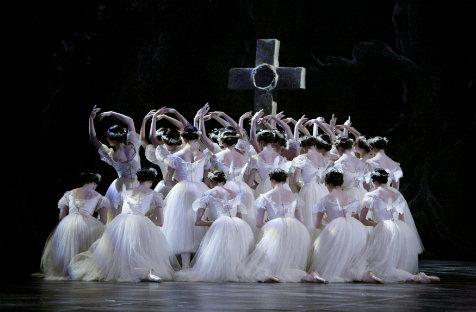We in Sydney are privileged to see the magnificent Paris Opera Ballet’s Giselle, the distilled essence of 19th century Romantic ballet, one of the defining works of dance history – yet here seeming as fresh as if it were created yesterday. A tale of love, betrayal, remorse and forgiveness, love of dance, love being stronger than death and ghosts, it was created on the company in 1841; the ballet’s eponymous role is regarded as one of the major test pieces for a ballerina.
It was exciting to note that a re-imagining of the sets from Alexandre Benois’ 1924 production were used for this re-imagined Giselle. We see the traditional Rhenish fairytale castle in the background, the large thatched cottage for Giselle and Berthe in Act One and an eerie, foggy wood in Act Two. The splendid costumes in Act One for Duke Albrecht, his fiancée Bathilde and other characters could have come from a bejewelled Book of Hours.
The dancing was superb from the entire ensemble, with great work from the Corps de Ballet, who were particularly well drilled in Act One, in the complicated group dances celebrating the harvest and entertaining the peasants’ unexpected noble visitors. In Act Two, as the Wilis (the ghosts of brides jilted before their wedding day) the women were superb. They were light and airy, yet under the cold direction of their leader, Myrthe, could also be quite menacing and threatening. (It was interesting to note the tiny phrases of music and choreography that briefly hinted and echoed Act Two in Act One). As the Wilis the corps breathed and pulsed as one and you could see the development to Petipa’s later La Bayadere. The ‘peasant pas de deux’ in Act One was also delightful.
As Giselle, Dorothee Gilbert is outstanding. In some ways this role is similar to that of Odette/Odile in Swan Lake, as in Act One you have the young girl – blushing, passionate about dance and head over heels in love with Albrecht; joyous, tender and teasing ( the pas de deux are magnificent ). Her mad scene is haunting, gripping and shattering. In Act Two this is contrasted with her steely pointes, thistledown lightness and incredible control in the legato sections. In Act Two, Gilbert varies from blurringly fast bourees to an incredible line full of aching longing. In Act Two the pas de deux are luminous and include some high Bolshoi-like flying lifts.
Our tall, handsome ‘hero’ Albrecht (Mathieu Ganio) was portrayed as a young man truly in love with Giselle and trapped in a very tricky situation. Ganio is an incredible dancer, letting loose a small series of jaw-dropping fireworks in a tiny solo in Act One and then brilliantly performing for the rest of the act. His solos in Act Two were tremendous, with magnificent cabrioles in the famous pas de deux, and he has a killing series of entrechats towards the end. No wonder he collapses in exhaustion! In Act Two you could feel his grief and sorrow. He is also a terrific partner.
Tall Hilarion, the gamekeeper desperately in love with Giselle, was excellently danced by Audric Bezard. At times he seemed quite towering and threatening.
As Myrthe, Queen of the Wilis, Marie-Agnes Gillot was electric – commanding, cold and eerie like a soft yet evil moonbeam. Giselle’s mother Berthe was excellently played by Amelie Lamoreux. Her big mime scene telling the story of the Wilis in Act One was chilling. (But why didn’t Giselle watch and listen? Had she heard it umpteen times before?)
The Sydney Lyric Orchestra under the dynamic conducting of Koen Kessels was tremendous.
An absolutely superb production that reminds us that old ‘warhorses’ of classic ballets are still relevant and can be magic today. Love conquers all.
Rating: 4 ½ stars out of 5
Paris Opera Ballet presents
Giselle
Music: Adolphe Adam
Choreography: Jean Coralli and Jules Perrot (1841) transmitted by Marius Petipa and adapted by Patrice Bart and Eugene Polyakov
Sets and costumes realised from the 1924 Alexandre Benois production
Costumes by Claude Gastine
Set design: Silvano Mattei
Sydney Lyric Orchestra conducted by Koen Kessels
Capitol Theatre, Sydney
29 January – 9 February





